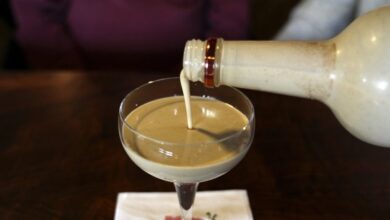Do you have Sriracha? The price for a bottle of Huy Fong’s iconic hot sauce is getting spicy with supplies running short

NEW YORK (AP) — It’s not just you. Sriracha is hard to come by these days – at least for one popular brand.
The shortage of Sriracha from Huy Fong Foods, the beloved red hot sauce packaged in those green-capped bottles, isn’t new — the company has been pointing out a chili pepper shortage for years. And while frustrated fans continue to see store shelves missing the Huy Fong name, third-party resellers are raising prices.
Huy Fong Sriracha, which used to go for less than $5 or $10 a bottle, is now selling for shocking amounts in some listings posted on huge third-party marketplace sites — including Amazon, eBay, and Walmart. Many are simply sold out.
For those still in stock, prices vary depending on where you look. As of Thursday morning, for example, ads for a single 17-ounce bottle on eBay ranged from about $20 to as much as $150 — contrasting significantly with the price tags of other hot sauce brands, which don’t seem to have the same level of supply issues.
Huy Fong told The Associated Press this week that it is still plagued by raw material shortages, following a similar scarcity last year when the company temporarily shut down. suspended sale of Sriracha and other popular products such as Chili Garlic and Sambal Oelek.
Huy Fong said on Wednesday that “limited production” has recently resumed, though the California company did not specify by how many or provide an estimate of when it believes suppliers will be able to supply a sufficient number of peppers.
“Because we do not sell directly to the retail/marketplace, we cannot determine when the product will be back on the shelves and/or who currently has the product in stock,” Huy Fong said in a prepared statement. “We are grateful for your continued patience and understanding during this unprecedented supply shortage.”
Here’s what you need to know.
WHY IS THERE A SHORTAGE OF HUY FONG SRIRACHA?
Some experts say Huy Fong’s shortage is partly a result of climate change, pointing to weather changes and extreme drought in Mexico and the southwestern US, where Huy Fong sources all of its chili peppers.
“The main culprit here is a shortage of their key ingredient, the red jalapeño pepper,” said David Ortega, a food economist and associate professor at Michigan State University. “And that is due to climate change and the mega drought.”
These peppers are usually grown under irrigation, with a lot of water being drawn from the Colorado River reached an unprecedented low level in recent years, Ortega said. The region has suffered from insufficient rainfall and reduced snow runoff.
Huy Fong’s problems with supplying Chile are not new. When the company halted sales last year, it referenced a 2020 email warning of a shortage of chili peppers, noting that the lack of supply had become more severe due to recent weather conditions.
But while climate change is affecting agriculture as a whole, it’s “not the whole story” for the current Huy Fong Sriracha shortage, says Stephanie Walker, a vegetable specialist and professor at New Mexico State University. She speculates that Huy Fong may not have enough suppliers with different growers and may want to build relationships with new growers.
“Last year (Huy Fong) just couldn’t get the jalapeños they needed,” says Walker, who also specializes in growing chiles. She noticed the contrast with the offerings of other brands. “It really comes down to relationships that individual processors have with their growers.”
She added that it looks like this year will be a strong season for the growth of jalapeño and other chili peppers in the region.
WHERE DOES HUY FONG GET HIS CHILI PEPPERS?
Founded decades ago by David Tran, Huy Fong currently sources its chili peppers from several farms in California, New Mexico and Mexico.
Prior to sourcing from these ranches, California-based Underwood Ranches was Huy Fong’s sole supplier for nearly 30 years. The partnership collapsed in 2017 after a financial dispute. Two years later, a jury found that Huy Fong had violated his contract with Underwood Ranches and also committed fraud – award of Underwood $23.3 million.
In a Thursday afternoon phone interview Craig Underwood, owner of Underwood Ranches, disagreed with drought and climate change explanations for Huy Fong’s deficit — arguing that Tran “has not rebuilt its supply chain as needed.”
According to Underwood, there is still a steady supply of jalapeño peppers from Mexico. Underwood Ranches, which now sells its own brand of Sriracha, also started production of red jalapeño peppers again this year, in part due to the Huy Fong shortage, he added.
“Demand for our product has increased quite a bit,” Underwood said.
DISH PRICES FROM
The erosion of available stocks from Huy Fong has shaken up the prices of the brand’s Sriracha, which is still available. In many places, the bottles are simply sold out, giving resellers leverage to bring the now hard-to-find and highly sought-after product to market.
Another market mechanism is consumer behaviour, in this case hording. The panic around potentially losing access to a desired product leads many people to buy more than they would normally need, as seen with toilet paper at the start of the COVID-19 pandemic.
“People are just stocking up and that’s exacerbating the situation,” said Ortega, also an expert on consumer decision making. “You have an increase in demand for the product on top of these supply shocks. And prices really have nowhere to go but up.”
DO OTHER HOT SAUCES COME WITH SHORTAGES?
There are a large number of hot sauces, including other Sriracha-style products, which are still easy to find at reasonable prices. For example, Tabasco created a page to help customers find nearby stores that carry its Sriracha brand — noting that it has been able to scale production to “meet most of the rising demand” for its sauce .
There are a few possible explanations for this, experts say. Some speculate that Huy Fong is having problems with its current chili suppliers. Other brands could also use other pepper varieties and source from more farms. Some may also be able to tinker with recipes, but perfecting sauces takes a long time, as does finding a new variety, experts say.
“Growing the crop in an area less affected by extreme weather conditions or breeding new varieties of the peppers that are more resistant to heat and, if possible, require less water would take years,” said Richard Howells, a supply chain expert at SAP. , wrote in a blog post earlier this week.




